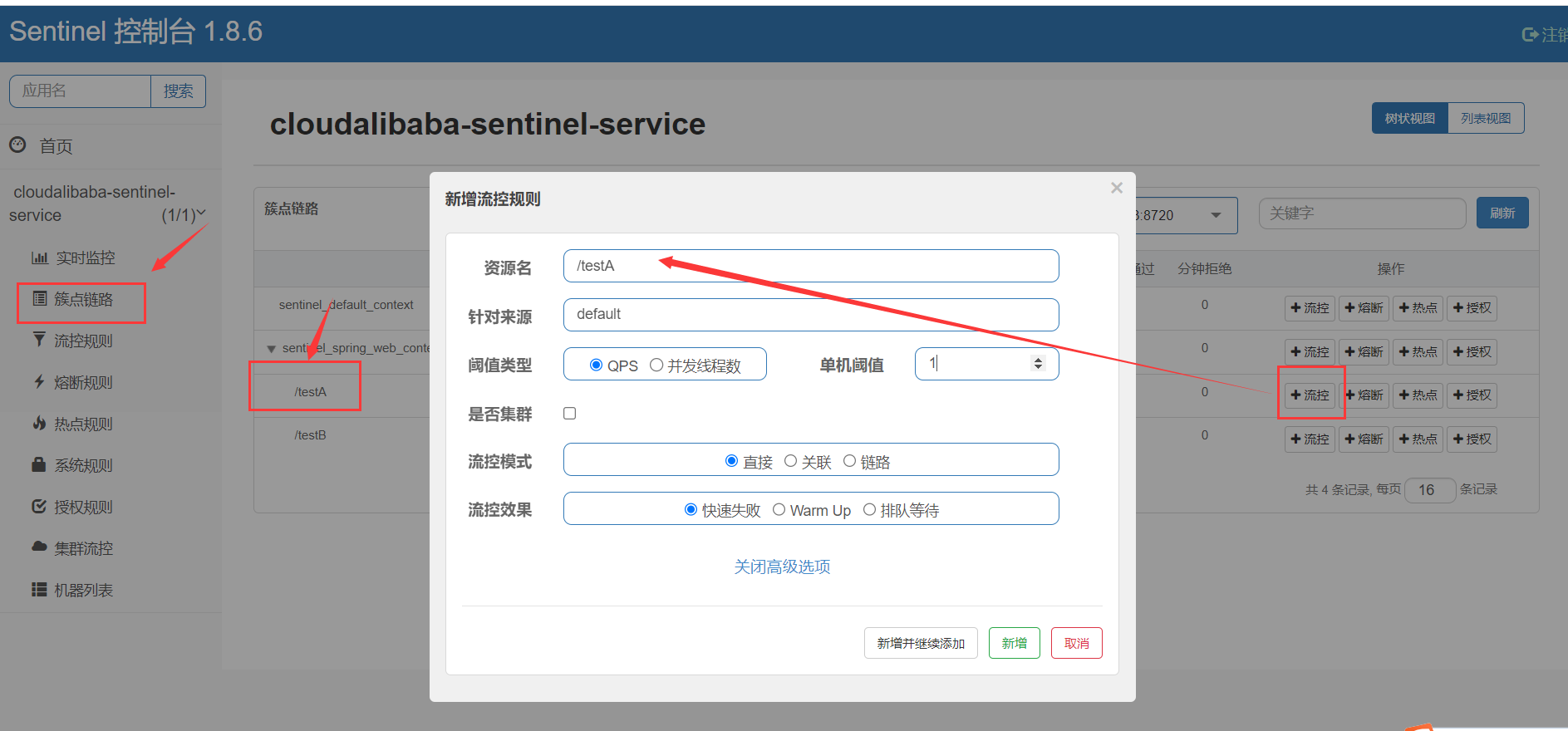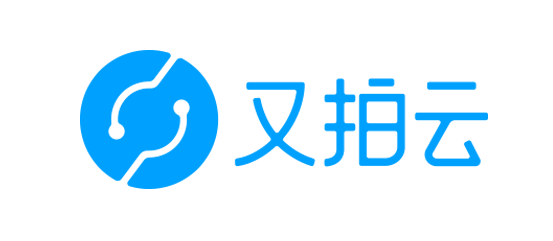 Sentinel
Sentinel
Table of Contents generated with DocToc (opens new window)
# Sentinel
# 概述
- GitHub:https://github.com/alibaba/Sentinel
- 官网:https://sentinelguard.io/zh-cn/
# hystrix的不足
- 需要手动搭建监控平台
- 没有一套web界面可以给我们进行更加细粒度化地对流控、速率、服务熔断、服务降级等进行控制
# Sentinel
其实就是前面的Hystrix的超集,但更加方便易用
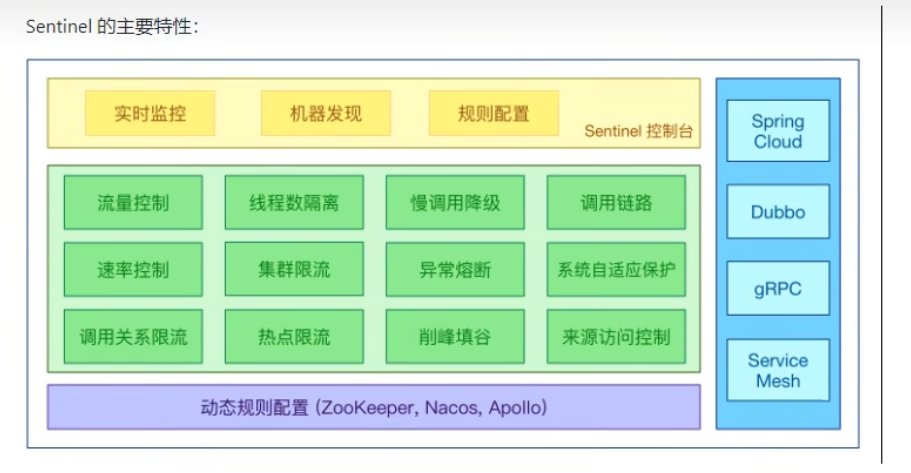
# 安装Sentinel控制台
直接在GitHub下载release版本的sentinel-dashboard.jar包即可,这里使用的是1.8.6版本
sentinel组件也是由两部分组成:即后台的监控程序+前台的dashboard
- 核心库(Java客户端):不依赖任何框架/,库,能够运行于所有Java运行环境,同时对Dubbo/SpringCloud等框架有较好的支持
- 控制台(Dashboard)基于SpringBoot开发,打包后可以直接运行,不需要额外的Tomcat等应用容器
# 安装步骤
- 下载好jar包以后,java -jar命令运行即可
- 通过 http://localhost:8080访问管理界面,账号密码均为
sentinel
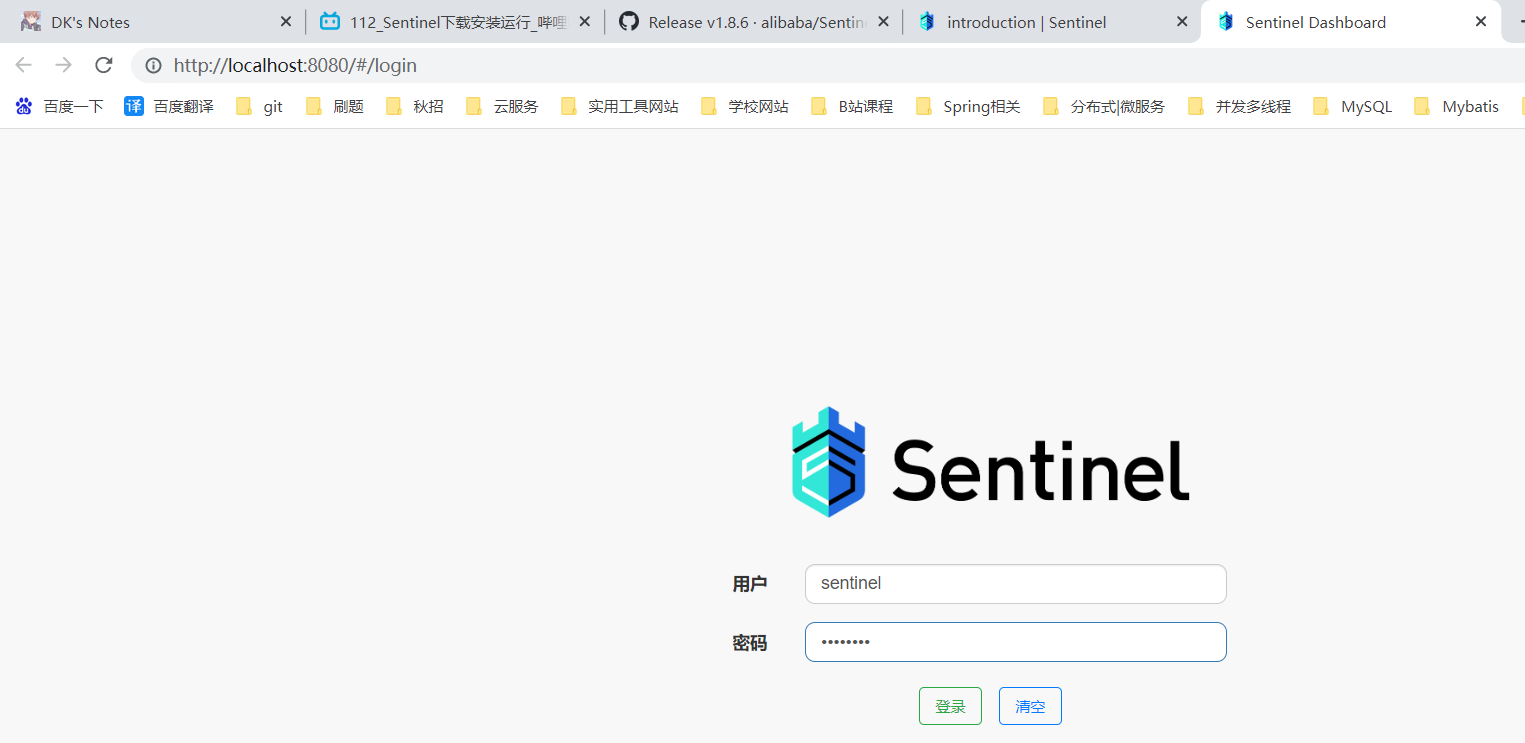

# 初始化演示工程
首先启动8848Nacos注册中心
然后,新建
cloudalibaba-sentinel-service8401模块
# cloudalibaba-sentinel-service8401
# pom
这里提前引入了一些后面需要的依赖,仅此处的话只需要nacos-discovery和spring-cloud-starter-alibaba-sentinel
<dependencies>
<!-- 通用的依赖-->
<dependency>
<groupId>com.zdk</groupId>
<artifactId>cloud-api-commons</artifactId>
<version>${project.version}</version>
</dependency>
<dependency>
<groupId>org.springframework.boot</groupId>
<artifactId>spring-boot-starter-web</artifactId>
</dependency>
<dependency>
<groupId>org.springframework.boot</groupId>
<artifactId>spring-boot-starter-actuator</artifactId>
</dependency>
<dependency>
<groupId>org.projectlombok</groupId>
<artifactId>lombok</artifactId>
<optional>true</optional>
</dependency>
<dependency>
<groupId>org.springframework.boot</groupId>
<artifactId>spring-boot-starter-test</artifactId>
<scope>test</scope>
</dependency>
<!-- nacos依赖 -->
<dependency>
<groupId>com.alibaba.cloud</groupId>
<artifactId>spring-cloud-starter-alibaba-nacos-discovery</artifactId>
</dependency>
<!-- ribbon依赖 -->
<dependency>
<groupId>org.springframework.cloud</groupId>
<artifactId>spring-cloud-starter-loadbalancer</artifactId>
</dependency>
<!-- sentinel依赖 -->
<dependency>
<groupId>com.alibaba.cloud</groupId>
<artifactId>spring-cloud-starter-alibaba-sentinel</artifactId>
</dependency>
<!-- 后续做持久化需要用到 -->
<dependency>
<groupId>com.alibaba.csp</groupId>
<artifactId>sentinel-datasource-nacos</artifactId>
</dependency>
<!-- openfeign -->
<dependency>
<groupId>org.springframework.cloud</groupId>
<artifactId>spring-cloud-starter-openfeign</artifactId>
</dependency>
</dependencies>
2
3
4
5
6
7
8
9
10
11
12
13
14
15
16
17
18
19
20
21
22
23
24
25
26
27
28
29
30
31
32
33
34
35
36
37
38
39
40
41
42
43
44
45
46
47
48
49
50
51
52
53
54
55
56
# yaml
server:
port: 8401
spring:
application:
name: cloudalibaba-sentinel-service
cloud:
nacos:
discovery:
#nacos 注册中心地址
server-addr: localhost:8848
sentinel:
transport:
# 配置Sentinel dashboard地址
dashboard: localhost:8080
# sentinel的端口 默认是8719 如果被占用会自动从8719开始依次+1扫描
# 直到找到未被占用的端口为止
port: 8719
# actuator的必要配置
management:
endpoints:
web:
exposure:
include: '*'
2
3
4
5
6
7
8
9
10
11
12
13
14
15
16
17
18
19
20
21
22
23
24
25
26
27
# 主启动类
@EnableDiscoveryClient
@SpringBootApplication
public class MainApp8401{
public static void main(String[] args){
SpringApplication.run(MainApp8401.class,args);
}
}
2
3
4
5
6
7
# 业务类FlowLimitController
@RestController
public class FlowLimitController {
@GetMapping(value = "/testA")
public String testA(){
return "------testA";
}
@GetMapping(value = "/testB")
public String testB(){
return "------testB";
}
}
2
3
4
5
6
7
8
9
10
11
12
13
14
- 然后启动Sentinel8080、启动新建微服务8401
- 启动后查看sentinel控制台
查看我们会发现并没有任何变化,这是因为sentinel是懒加载,我们只需要访问一次接口:
http://localhost:8401/testA 即可看到变化
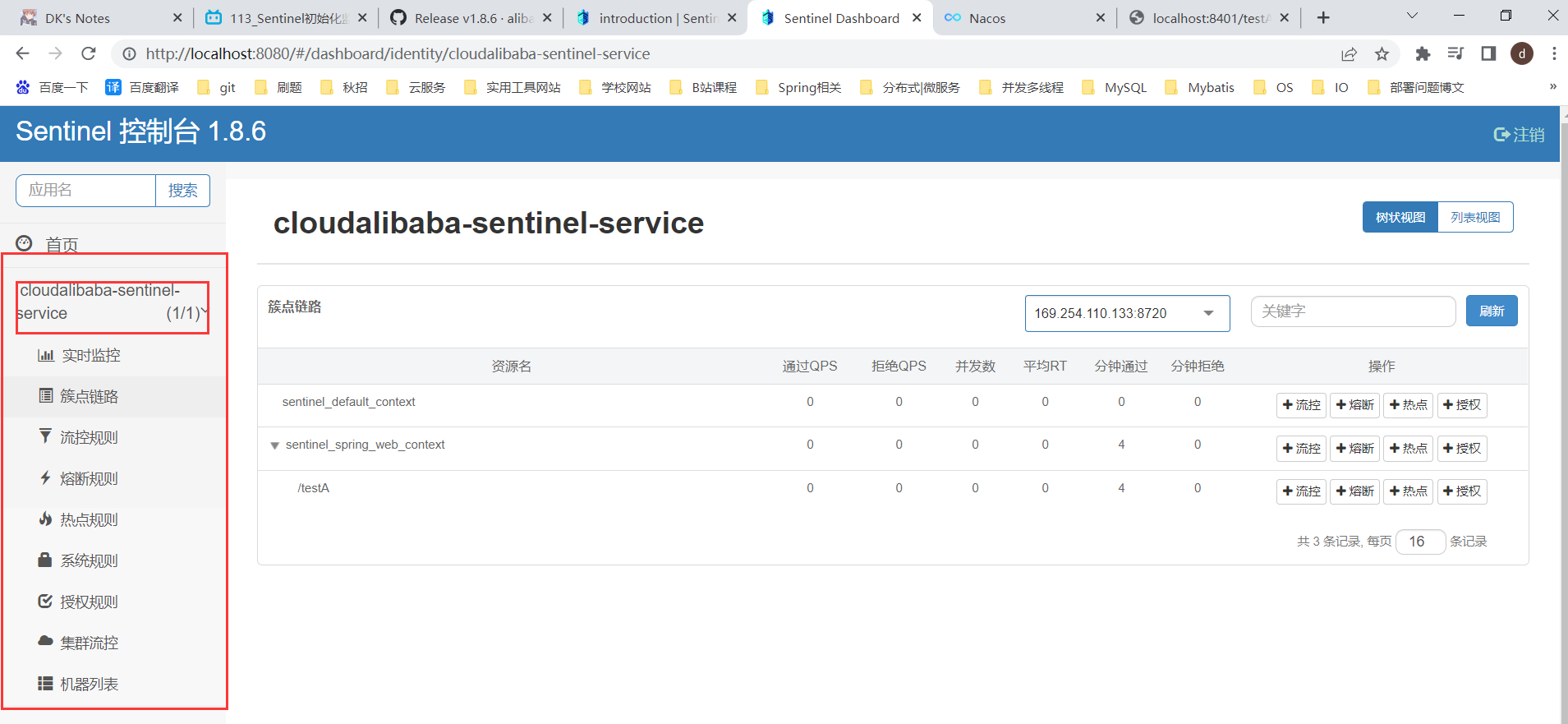
多访问几次接口就会出现实时监控的图表信息
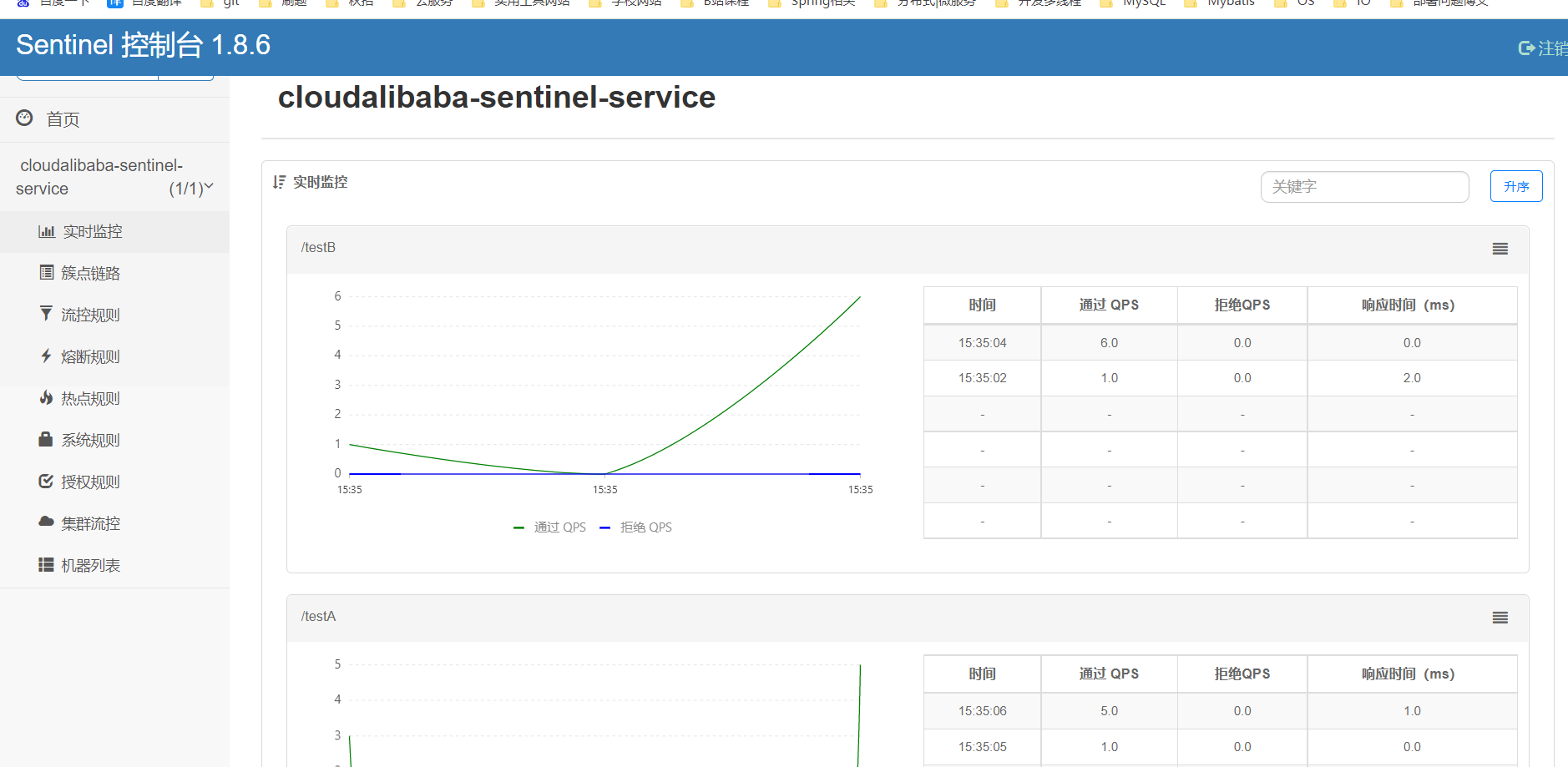
这就证实了sentinel正在监控8401微服务
# 流控规则
# 基本介绍
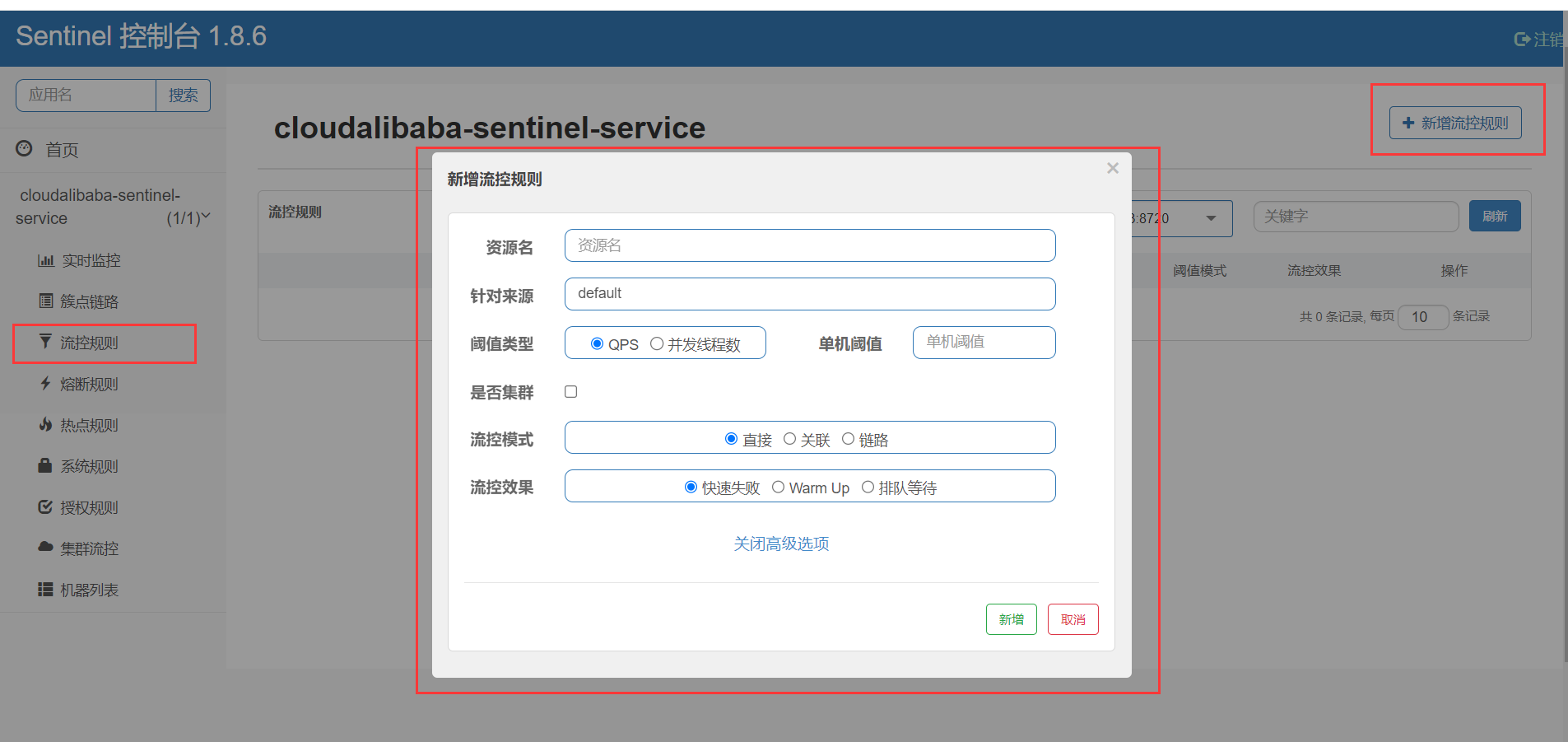
# 进一步解释说明
- 资源名:唯一名称,默认为请求的路径
- 针对来源:Sentinel可以针对调用者进行限流,填写微服务名,默认default(不区分来源)
- 阈值类型/单机阈值:
- QPS(每秒钟的请求数量):当调用该api的QPS达到设置的阈值时,进行限流
- 线程数:当调用该api的线程数达到设定的阈值时,进行限流
- 是否集群:sentinel是否是集群
- 流控模式:
- 直接:api达到限流条件时,直接限流
- 关联:当关联的资源达到阈值时,就限流自己
- 链路:只记录指定链路上的流量(指定资源从入口资源进来的流量,如果达到阈值,就进行限流)[api级别的针对来源]
- 流控效果:
- 快速失败:直接失败,抛出异常
- Warm Up:根据coldFactor(冷加载因子,默认3)的值,从阈值/coldFactor,经过预热时长,才达到设置的QPS阈值
# 流控模式
一般我们在簇点链路这里添加流控规则,因为资源名有了,不用再写,当然也可以在流控规则菜单添加
# 直接(默认)
按照上图新增一个模式为直接的流控规则,QPS为1,这时对testA接口进行测试,1秒内多次点击,会出现
Blocked by Sentinel (flow limiting)的提示,因为我们设置的每秒只能请求1次,若超过次数,就直接-快速失败,报默认错误

# QPS
设置阈值类型为QPS时,是限制api每秒能接受的请求的个数,相当于多余的请求还未进入到应用程序就被限制
# 线程数
设置线程数,是限制这个api,同时只有设置的个数的线程在处理请求,假设我们设定线程数阈值为1,这时如果一个请求还未处理完,另一个请求又进来了,这个新进的请求就会出现
Blocked by Sentinel (flow limiting)
# 关联
即当关联的资源达到阈值的时候,就限流自己,比如接口A关联了接口B,此时接口B达到阈值了,A就该对自己限流了
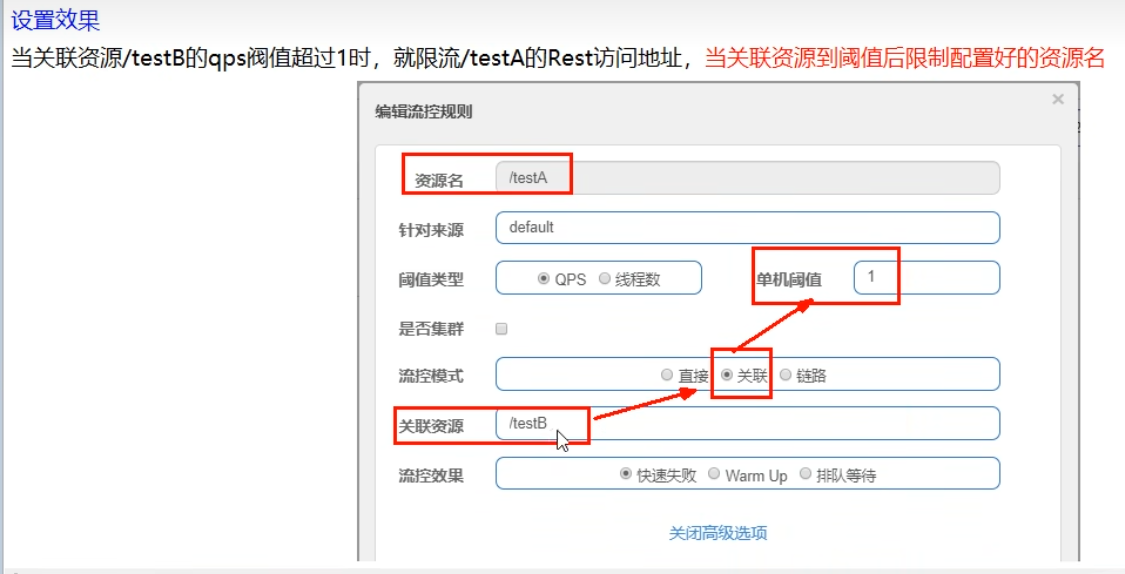
我们用postman模拟对testB接口的并发密集访问,20个线程每0.3秒访问一次testB接口
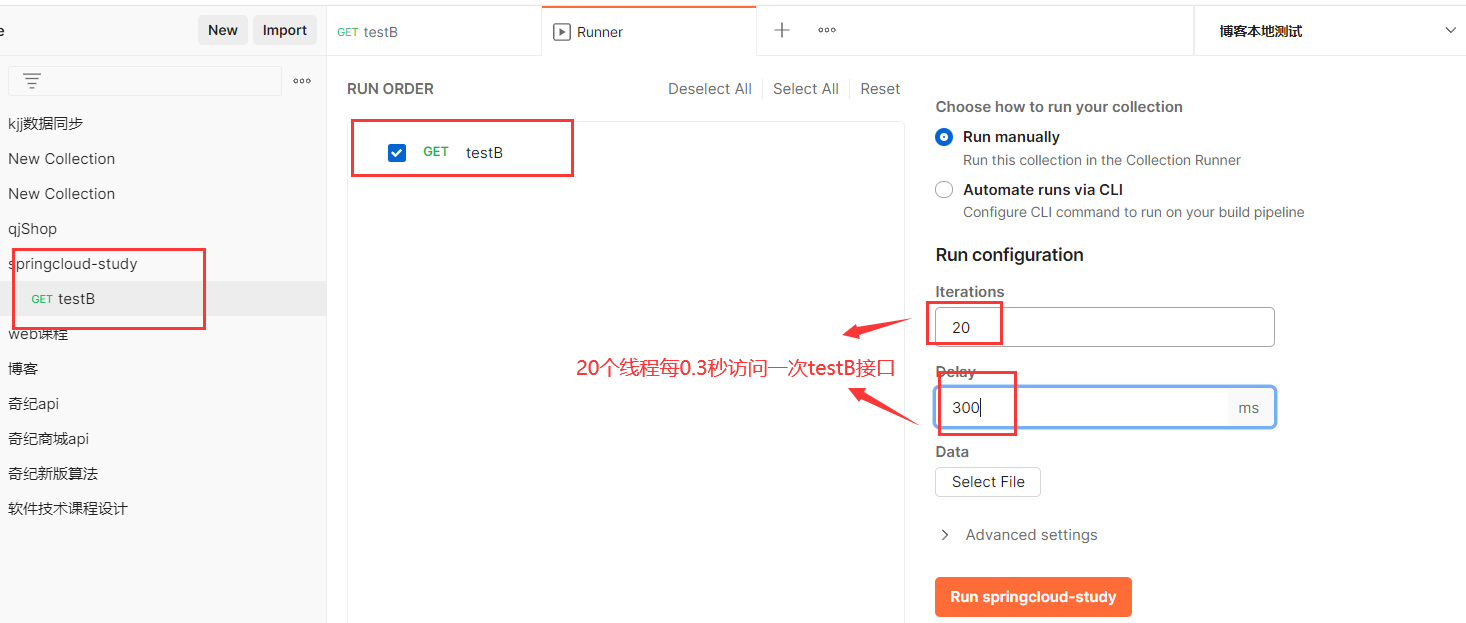
执行这个集合后再去访问testA,即限流成功,而等20个线程0.3秒共6秒访问testB完毕后,testA调用恢复正常

# 链路
多个请求调用同一个微服务
# 流控效果
# 直接->快速失败(默认效果)
刚才已经测试了,即:直接失败,抛出异常Blocked by Sentinel (flow limiting)
源码:com.alibaba.csp.sentinel.slots.block.flow.controller
# 预热(Warm Up)
Warm Up (RuleConstant.CONTROL_BEHAVIOR_WARM_UP)方式,即预热/冷启动方式。当系统长期处于低水位的情况下,当流量突然增加时,直接把系统拉升到高水位可能瞬间把系统压垮。通过"冷启动",让通过的流量缓慢增加,在一定时间内逐渐增加到阈值上限,给冷系统一个预热的时间,避免冷系统被压垮。
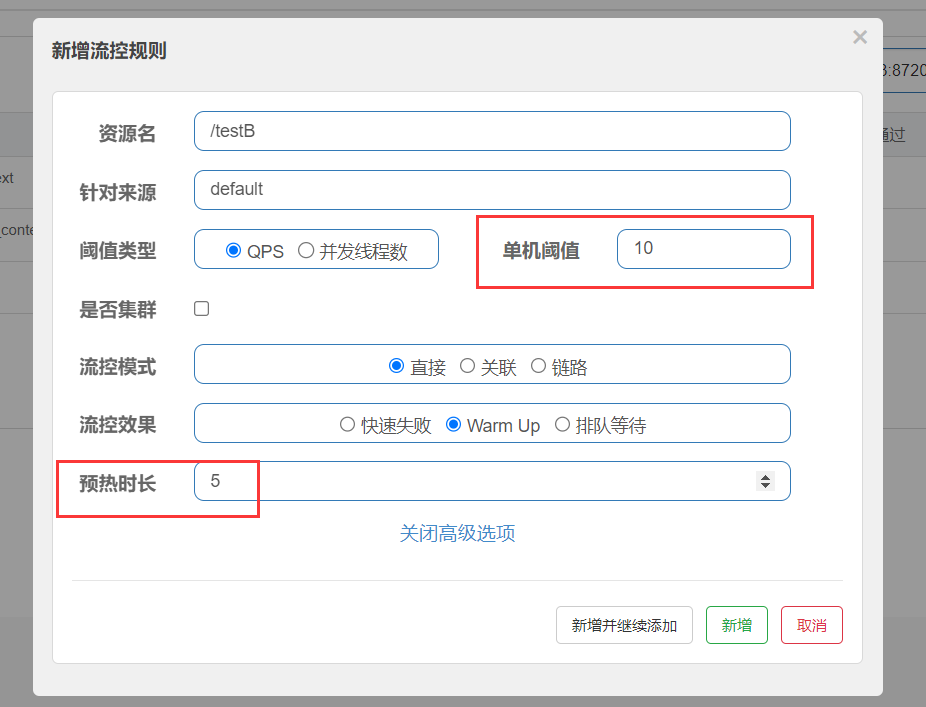
根据设置的这个图通俗解释一下:
在sentinel中,默认的冷加载因子coldFactor是3,所以在刚开始的时候,testB接口的QPS的阈值为 threshold/coldFactor = 10/3 = 3,然后预热时长为5(单位是秒),表示从接口第一次被访问开始的5秒内,testB的QPS阈值都是3,要直到5秒后,testB接口的QPS阈值才会从3慢慢上升到我们设置的10
# 应用场景
如:秒杀系统在开启的瞬间,会有很多流量上来,很有可能把系统打死,预热方式就是把为了保护系统,可慢慢的把流量放进来,慢慢的把阀值增长到设置的阀值。
或者对应到缓存,先放一部分让缓存成功出现,再放大部分进来就都能走缓存而不是打到数据库了
# 排队等待
- 匀速排队,让请求以均匀的速度通过,阈值类型必须设为QPS,否则无效
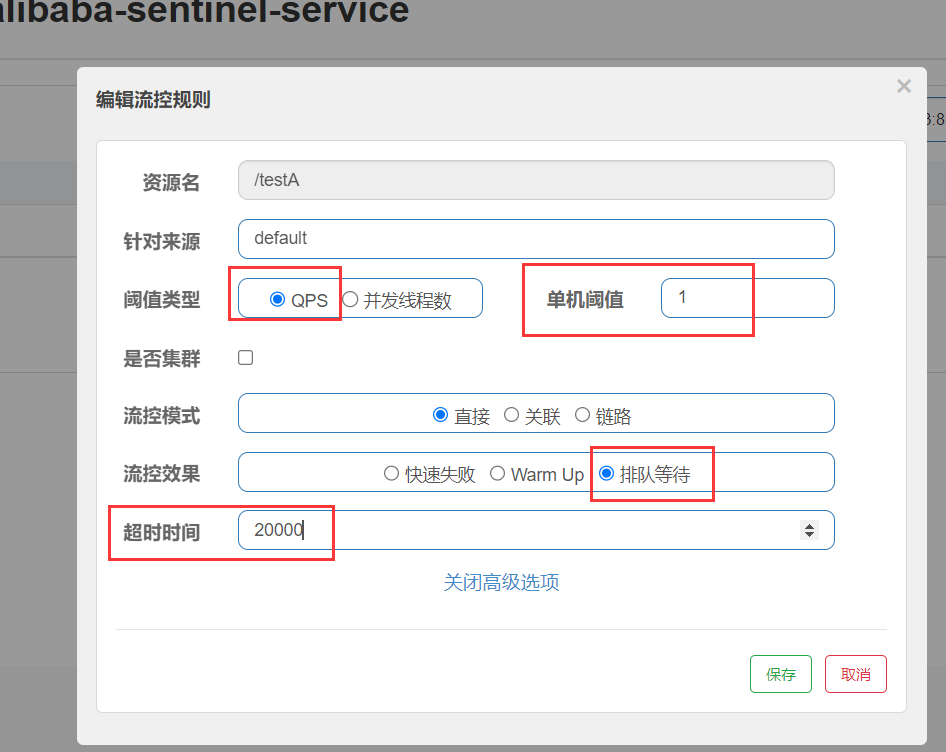
- 设置含义:testA每秒1次请求,超过的话就排队等待,等待的超时时间为20000毫秒
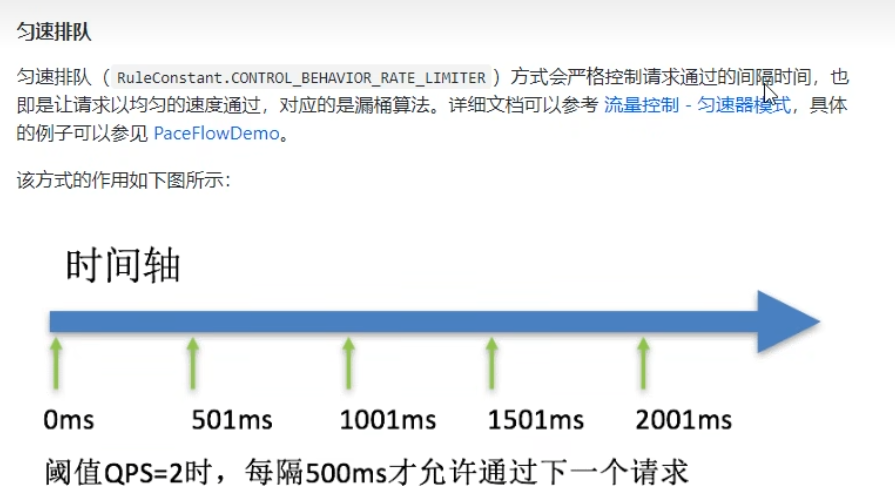
这种方式主要用于处理间隔性突发的流量,例如消息队列。想象一下这样的场景,在某一秒有大量的请求到来,而接下来的几秒则处于空闲状态,我们希望系统能够在接下来的空闲期间逐渐处理这些请求,而不是在第一秒直接拒绝多余的请求。
# 降级规则
Sentinel熔断降级会在调用链路中某个资源出现不稳定状态时(例如调用超时或异常比例升高),对这个资源的调用进行限制,让请求快速失败,避免影响到其它的资源而导致级联错误。
当资源被降级后,在接下来的熔断时间之内,对该资源的调用都自动熔断(默认行为是抛出DegradeException)。
# 慢调用比例
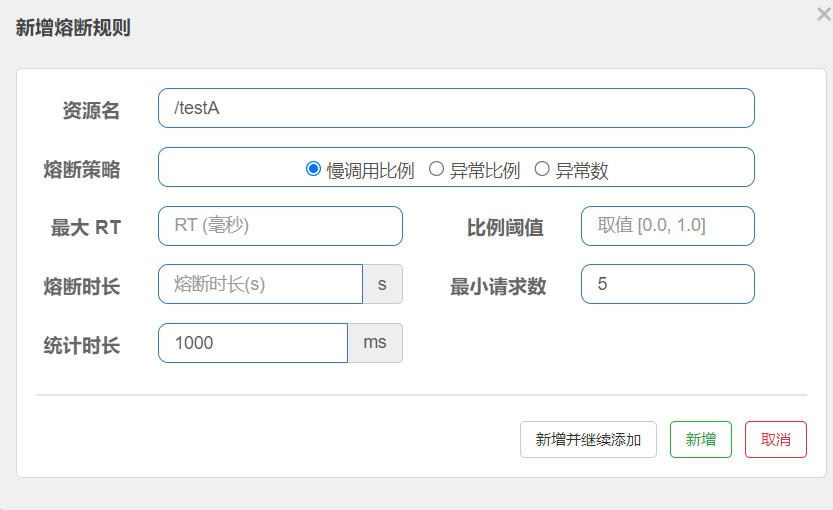
慢调用比例 (
SLOW_REQUEST_RATIO):选择以慢调用比例作为阈值,需要设置允许的慢调用 RT(即最大的响应时间),请求的响应时间大于该值则统计为慢调用。当单位统计时长(statIntervalMs)内请求数目大于设置的最小请求数目,并且慢调用的比例大于阈值,则接下来的熔断时长内请求会自动被熔断。经过熔断时长后熔断器会进入探测恢复状态(HALF-OPEN 状态),若接下来的一个请求响应时间小于设置的慢调用 RT 则结束熔断,若大于设置的慢调用 RT 则会再次被熔断。
执行的条件:
统计时长单位内请求数>=最小请求数 & 这些请求的平均响应时间大于统计时长 & 响应时间大于RT的请求数占总请求数的比例>设定的比例阈值
# 异常比例
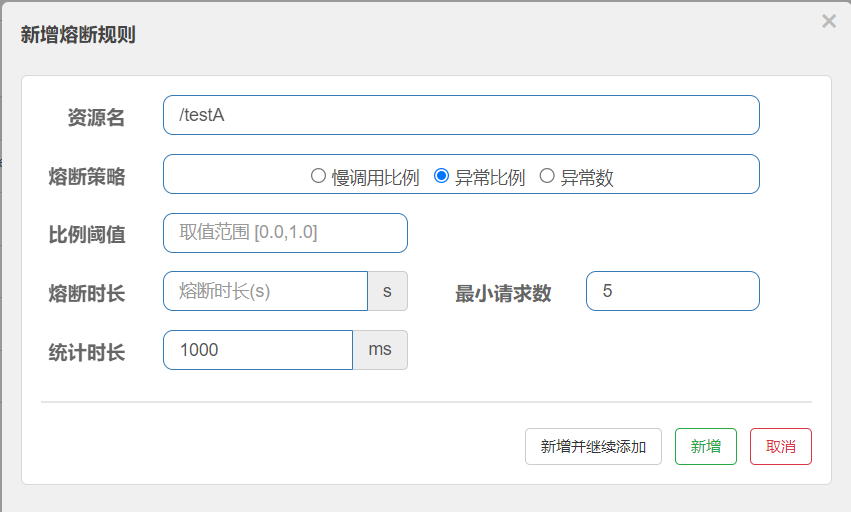
异常比例 (
ERROR_RATIO):当单位统计时长(statIntervalMs)内请求数目大于设置的最小请求数目,并且异常的比例大于阈值,则接下来的熔断时长内请求会自动被熔断。经过熔断时长后熔断器会进入探测恢复状态(HALF-OPEN 状态),若接下来的一个请求成功完成(没有错误)则结束熔断,否则会再次被熔断。异常比率的阈值范围是[0.0, 1.0],代表 0% - 100%。
执行的条件:
统计时长单位内请求数>=设定的最小请求数 & 出现异常的请求占比>设定的异常比例阈值
# 异常数
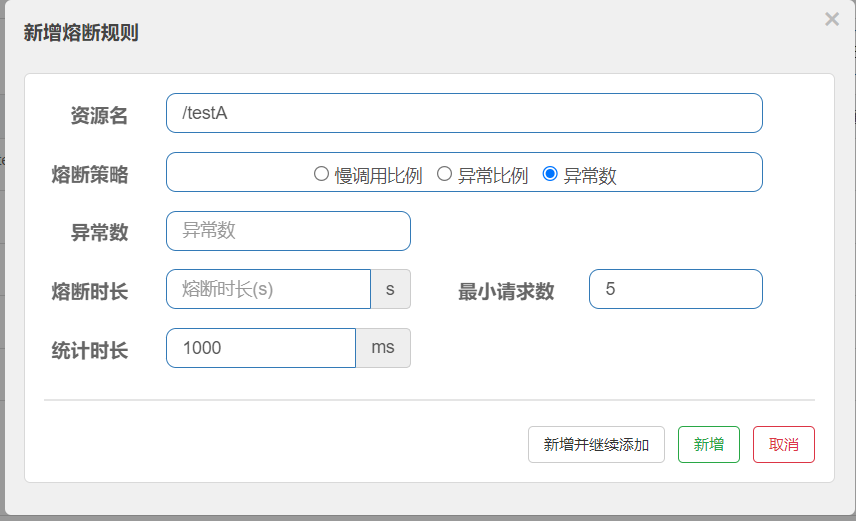
异常数 (
ERROR_COUNT):当单位统计时长内的异常数目超过阈值之后会自动进行熔断。经过熔断时长后熔断器会进入探测恢复状态(HALF-OPEN 状态),若接下来的一个请求成功完成(没有错误)则结束熔断,否则会再次被熔断。
注意异常降级仅针对业务异常,对 Sentinel 限流降级本身的异常(BlockException)不生效
# 热点key限流
何为热点?热点即经常访问的数据。很多时候我们希望统计某个热点数据中访问频次最高的 Top K 数据,并对其访问进行限制。比如:
- 商品 ID 为参数,统计一段时间内最常购买的商品 ID 并进行限制
- 用户 ID 为参数,针对一段时间内频繁访问的用户 ID 进行限制
热点参数限流会统计传入参数中的热点参数,并根据配置的限流阈值与模式,对包含热点参数的资源调用进行限流。热点参数限流可以看做是一种特殊的流量控制,仅对包含热点参数的资源调用生效。
Sentinel 利用 LRU 策略统计最近最常访问的热点参数,结合令牌桶算法来进行参数级别的流控。
# 测试接口
@GetMapping(value = "/testHotKey")
//blockHandler用来指定不满足规则时的处理方法
//这个处理方法的参数类型和数量要和原接口一致,并新增一个BlockException类型的参数
//testHotKey为热点资源名称,配置时与代码中要一致
@SentinelResource(value = "testHotKey",blockHandler = "handleHotKey")
public String testHotKey(@RequestParam(value = "p1",required = false) String p1,
@RequestParam(value = "p2",required = false) String p2){
return "------testHotKey";
}
public String handleHotKey(String p1, String p2, BlockException exception){
return "------handleHotKey---------";
}
2
3
4
5
6
7
8
9
10
11
12
13
# 添加热点规则配置
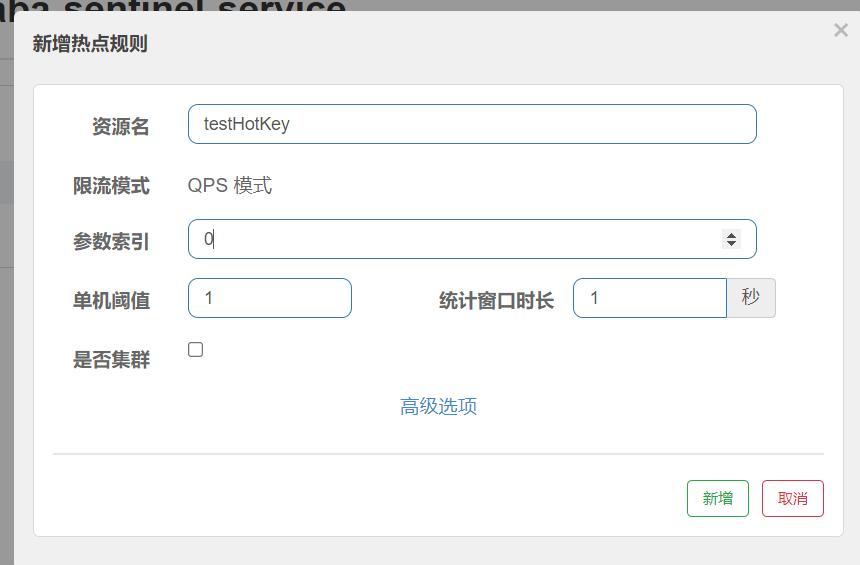
# 测试结果
这里我们带着p1这个参数(这个参数在接口方法中的索引是0,即第一个参数)去访问接口,一秒内多次访问,即会走到blockHandler设定的方法,触发热点key限流

- 如果访问http://localhost:8401/testHotKey?p2=aaa,则不会触发限流,因为p2的参数索引是1而不是我们设置的0
- 如果访问http://localhost:8401/testHotKey?p1=aaa&p2=aaa,也会触发限流
# 参数例外项
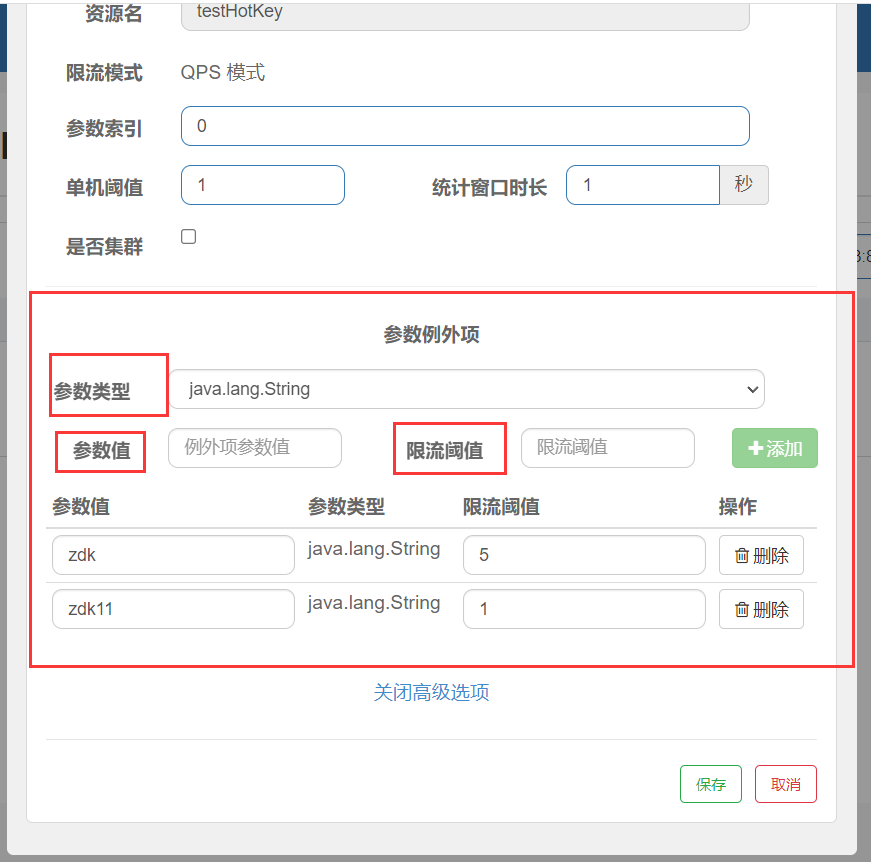
上述的示例演示了第一个参数p1,当QPS超过1秒1次点击后马上被限流,但是这种情况不灵活,因为总有例外的情况,我们可能会希望这个参数的值为xx的时候,不被限流,或者被限流的阈值更大
- 特例情况:
- 普通:超过1秒一个后,达到阈值1马上被限流
- 我们期望p1参数当它是某个特殊值时,它的限流规则和平时不一样
- 特例:假如当p1的值为5时,它的阈值可以达到200
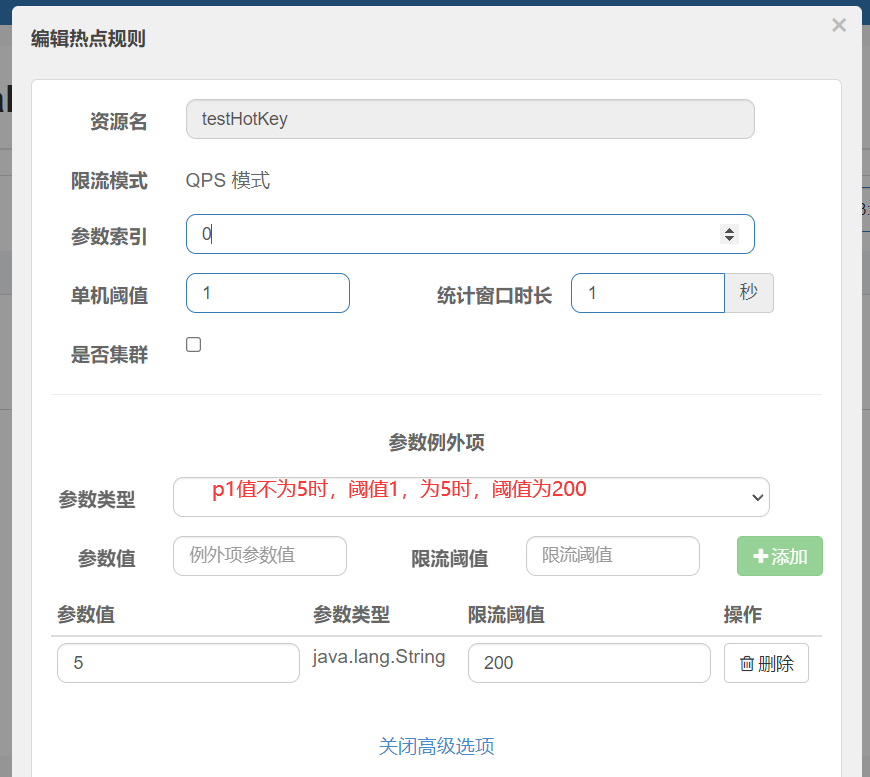
测试多次访问http://localhost:8401/testHotKey?p1=1、http://localhost:8401/testHotKey?p1=5可以发现,p1为5时,并没有被限流了
# 异常情况
我们在接口中增加一句代码
int a = 10/0;,再尝试去调用接口会发现,并没有走blockHandler指定的方法,也没有返回默认的异常,而是直接出现了Spring Boot默认的500页面
这是因为
@SentinelResource处理的是Sentinel控制台配置的违规情况,有blockHandler方法配置的兜底处理,而我们增加的int a = 10/0;是Java运行时异常,@SentinelResource并不会进行处理
# 系统规则
Sentinel 系统自适应保护从整体维度对应用入口流量进行控制,结合应用的 Load、总体平均 RT、入口 QPS 和线程数等几个维度的监控指标,让系统的入口流量和系统的负载达到一个平衡,让系统尽可能跑在最大吞吐量的同时保证系统整体的稳定性。
# 概念
系统保护规则是从应用级别的入口流量进行控制,从单台机器的总体 Load、RT、入口 QPS 和线程数四个维度监控应用数据,让系统尽可能跑在最大吞吐量的同时保证系统整体的稳定性。
系统保护规则是应用整体维度的,而不是资源维度的,并且仅对入口流量生效。入口流量指的是进入应用的流量(
EntryType.IN),比如 Web 服务或 Dubbo 服务端接收的请求,都属于入口流量。系统规则支持以下的阈值类型:
- Load(仅对 Linux/Unix-like 机器生效):当系统 load1 超过阈值,且系统当前的并发线程数超过系统容量时才会触发系统保护。系统容量由系统的
maxQps * minRt计算得出。设定参考值一般是CPU cores * 2.5。- CPU usage(1.5.0+ 版本):当系统 CPU 使用率超过阈值即触发系统保护(取值范围 0.0-1.0)。
- RT:当单台机器上所有入口流量的平均 RT 达到阈值即触发系统保护,单位是毫秒。
- 线程数:当单台机器上所有入口流量的并发线程数达到阈值即触发系统保护。
- 入口 QPS:当单台机器上所有入口流量的 QPS 达到阈值即触发系统保护。
这里以QPS=1测试一下,访问正常的testA和testB接口,同时访问就会有一个出现Blocked by Sentinel (flow limiting)
# @SentinelResource
# 按资源名称限流+后续处理
8401模块新增RateLimitController
@RestController
public class RateLimitController {
@GetMapping(value = "/byResource")
@SentinelResource(value = "byResource",blockHandler = "handleException")
public CommonResult byResource(){
return new CommonResult(200, "按资源名称限流测试OK",new Payment(2022L, "serial0001"));
}
public CommonResult handleException(BlockException exception){
return new CommonResult(444, exception.getClass().getCanonicalName()+"\t 服务不可用");
}
}
2
3
4
5
6
7
8
9
10
11
12
13
14
按资源名设定限流规则:

多次点击,出现限流,返回我们自定义的handler

# 额外问题
关闭服务8401,发现流控规则消失了
# 按url地址限流+后续处理
新增controller接口
@GetMapping(value = "/byUrl")
@SentinelResource(value = "byUrl")
public CommonResult byUrl(){
return new CommonResult(200, "按url限流测试OK",new Payment(2022L, "serial0002"));
}
2
3
4
5
这里没有写
blockHandler配置,限流返回的Sentinel默认的提示
# 上面兜底方案面临的问题
- Sentinel默认的限流提示,没有体现我们自己的业务要求
- 依照现有条件,我们自定义的处理方法又和业务代码耦合在一块,不直观
- 每个业务方法都添加一个兜底的,那代码膨胀加剧
- 全局统一的处理方法没有体现
# 自定义限流处理逻辑
# 创建CustomerBlockHandler
public class CustomerBlockHandler {
public static CommonResult handleException(BlockException exception){
return new CommonResult(444, "按客户自定义,global handleException----1");
}
public static CommonResult handleException2(BlockException exception){
return new CommonResult(444, "按客户自定义,global handleException----2");
}
}
2
3
4
5
6
7
8
9
# 配置@SentinelResource参数
@GetMapping(value = "/rateLimit/customerBlockHandler")
@SentinelResource(value = "customerBlockHandler",
// 指定处理的类
blockHandlerClass = CustomerBlockHandler.class,
// 指定类中的哪个方法来处理
blockHandler = "handleException2")
public CommonResult customerBlockHandler(){
return new CommonResult(200, "按自定义限流测试OK",new Payment(2022L, "serial0003"));
}
2
3
4
5
6
7
8
9
# 测试
这里进行配置的时候,必须对
@SentinelResource的value作为资源名来配置限流规则,才能生效,而配置url为资源名则不会走自定义的兜底

# 更多注解属性说明
SphU定义资源
Tracer定义统计
ContextUtil定义上下文
# 服务熔断功能
# 整合loadbalancer+fallback
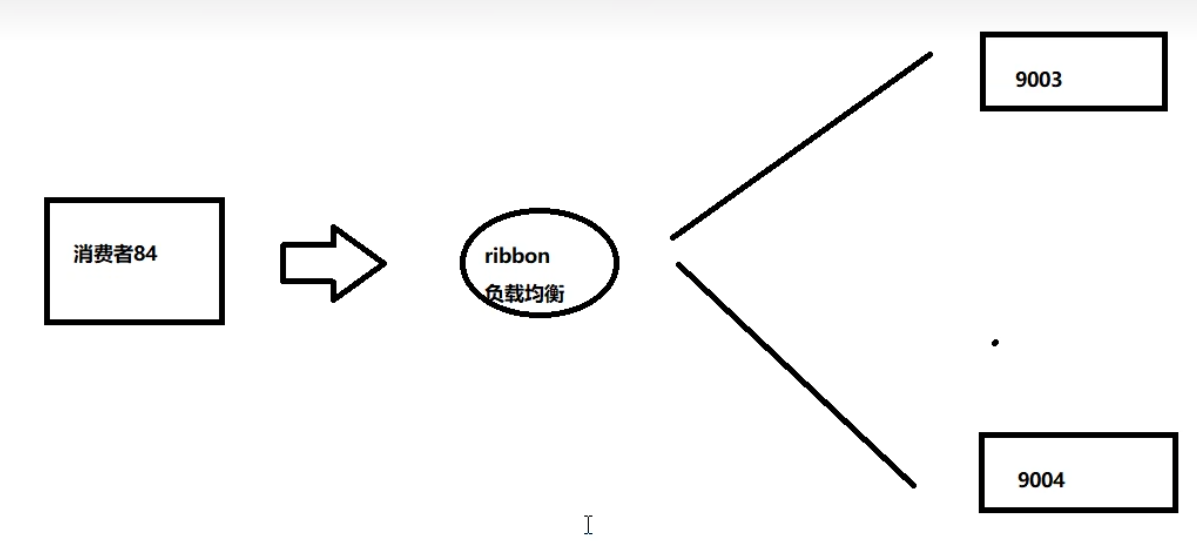
所以需要新建3个模块
- cloudalibaba-provider-payment9003/9003
- cloudalibaba-consumer-nacos-order84
# provider(9003为例)
# pom
<dependencies>
<!-- 通用的依赖-->
<dependency>
<groupId>com.zdk</groupId>
<artifactId>cloud-api-commons</artifactId>
<version>${project.version}</version>
</dependency>
<dependency>
<groupId>org.springframework.boot</groupId>
<artifactId>spring-boot-starter-web</artifactId>
</dependency>
<dependency>
<groupId>org.springframework.boot</groupId>
<artifactId>spring-boot-starter-actuator</artifactId>
</dependency>
<dependency>
<groupId>org.projectlombok</groupId>
<artifactId>lombok</artifactId>
<optional>true</optional>
</dependency>
<dependency>
<groupId>org.springframework.boot</groupId>
<artifactId>spring-boot-starter-test</artifactId>
<scope>test</scope>
</dependency>
<!-- nacos依赖 -->
<dependency>
<groupId>com.alibaba.cloud</groupId>
<artifactId>spring-cloud-starter-alibaba-nacos-discovery</artifactId>
</dependency>
<!-- openfeign依赖 -->
<dependency>
<groupId>org.springframework.cloud</groupId>
<artifactId>spring-cloud-starter-openfeign</artifactId>
</dependency>
<!-- loadbalancer依赖 -->
<dependency>
<groupId>org.springframework.cloud</groupId>
<artifactId>spring-cloud-starter-loadbalancer</artifactId>
</dependency>
</dependencies>
2
3
4
5
6
7
8
9
10
11
12
13
14
15
16
17
18
19
20
21
22
23
24
25
26
27
28
29
30
31
32
33
34
35
36
37
38
39
40
41
42
43
44
# yaml
server:
port: 9003
spring:
application:
name: nacos-payment-provider
cloud:
nacos:
discovery:
server-addr: localhost:8848
management:
endpoints:
web:
exposure:
include: '*'
2
3
4
5
6
7
8
9
10
11
12
13
14
15
16
17
# 主启动类
@EnableDiscoveryClient
@SpringBootApplication
public class PaymentMain9003{
public static void main(String[] args){
SpringApplication.run(PaymentMain9003.class,args);
}
}
2
3
4
5
6
7
# 业务类
@RestController
public class PaymentController {
@Value("${server.port}")
private String serverPort;
public static HashMap<Long, Payment> hashMap = new HashMap<>();
static {
hashMap.put(1L,new Payment(1L, "256asdsadasd51a65s1d65ad165"));
hashMap.put(2L,new Payment(2L, "j1211434shdas1a65s1d65ad165"));
hashMap.put(3L,new Payment(3L, "256asdsadasddf11541asdada65"));
}
@GetMapping(value = "/paymentSQL/{id}")
public CommonResult<Payment> paymentSQL(@PathVariable("id") Long id){
Payment payment = hashMap.get(id);
return new CommonResult<>(200,"from mysql,serverPort: "+serverPort,payment);
}
}
2
3
4
5
6
7
8
9
10
11
12
13
14
15
16
17
18
19
20
21
# consumer84
cloudalibaba-consumer-nacos-order84
# pom
<dependencies>
<!-- 通用的依赖-->
<dependency>
<groupId>com.zdk</groupId>
<artifactId>cloud-api-commons</artifactId>
<version>${project.version}</version>
</dependency>
<dependency>
<groupId>org.springframework.boot</groupId>
<artifactId>spring-boot-starter-web</artifactId>
</dependency>
<dependency>
<groupId>org.springframework.boot</groupId>
<artifactId>spring-boot-starter-actuator</artifactId>
</dependency>
<dependency>
<groupId>org.projectlombok</groupId>
<artifactId>lombok</artifactId>
<optional>true</optional>
</dependency>
<dependency>
<groupId>org.springframework.boot</groupId>
<artifactId>spring-boot-starter-test</artifactId>
<scope>test</scope>
</dependency>
<!-- nacos依赖 -->
<dependency>
<groupId>com.alibaba.cloud</groupId>
<artifactId>spring-cloud-starter-alibaba-nacos-discovery</artifactId>
</dependency>
<!-- openfeign依赖 -->
<dependency>
<groupId>org.springframework.cloud</groupId>
<artifactId>spring-cloud-starter-openfeign</artifactId>
</dependency>
<!-- loadbalancer依赖 -->
<dependency>
<groupId>org.springframework.cloud</groupId>
<artifactId>spring-cloud-starter-loadbalancer</artifactId>
</dependency>
<!-- sentinel依赖 -->
<dependency>
<groupId>com.alibaba.cloud</groupId>
<artifactId>spring-cloud-starter-alibaba-sentinel</artifactId>
</dependency>
<!-- 后续做持久化需要用到 -->
<dependency>
<groupId>com.alibaba.csp</groupId>
<artifactId>sentinel-datasource-nacos</artifactId>
</dependency>
</dependencies>
2
3
4
5
6
7
8
9
10
11
12
13
14
15
16
17
18
19
20
21
22
23
24
25
26
27
28
29
30
31
32
33
34
35
36
37
38
39
40
41
42
43
44
45
46
47
48
49
50
51
52
53
54
# yaml
server:
port: 84
spring:
application:
name: nacos-order-consumer
cloud:
nacos:
discovery:
server-addr: localhost:8848
sentinel:
transport:
port: 8719
dashboard: localhost:8080
#消费者将要去访问的服务名
service-url:
nacos-user-service: http://nacos-payment-provider
2
3
4
5
6
7
8
9
10
11
12
13
14
15
16
17
18
19
# 业务类
@Configuration
public class ApplicationContextConfig {
@Bean
@LoadBalanced
public RestTemplate restTemplate(){
return new RestTemplate();
}
}
2
3
4
5
6
7
8
9
10
# 不配置fallback和blockHandler
遇到Java的异常,会直接返回默认的500页面
# 只配置fallback
@GetMapping(value = "/consumer/fallback/{id}")
@SentinelResource(value = "fallback",fallback = "handlerFallback")//fallback只负责业务异常
public CommonResult<Payment> fallback(@PathVariable("id") Long id){
CommonResult res = restTemplate.getForObject(SERVICE_URL + "/paymentSQL/" + id, CommonResult.class);
if (id == 4){
throw new IllegalArgumentException("IllegalArgumentException,非法参数异常.....");
}else if (res.getData() == null){
throw new NullPointerException("NullPointerException,该id没有对应记录,空指针异常.....");
}
return res;
}
public CommonResult<Payment> handlerFallback(@PathVariable("id") Long id,Throwable e){
Payment payment = new Payment(id, "null");
return new CommonResult<>(444, "兜底异常handlerFallback,exception内容 "+e.getMessage(),payment);
}
2
3
4
5
6
7
8
9
10
11
12
13
14
15
16

走我们的兜底方法
# 只配置blockHandler
@GetMapping(value = "/consumer/fallback/{id}")
@SentinelResource(value = "fallback",blockHandler = "blockHandler")//blockHandler只负责sentinel控制台配置违规
public CommonResult<Payment> fallback(@PathVariable("id") Long id){
CommonResult res = restTemplate.getForObject(SERVICE_URL + "/paymentSQL/" + id, CommonResult.class);
if (id == 4){
throw new IllegalArgumentException("IllegalArgumentException,非法参数异常.....");
}else if (res.getData() == null){
throw new NullPointerException("NullPointerException,该id没有对应记录,空指针异常.....");
}
return res;
}
public CommonResult<Payment> blockHandler(@PathVariable("id") Long id, BlockException blockException){
Payment payment = new Payment(id, "null");
return new CommonResult<>(444, "blockHandler-sentinel限流,无此流水:blockException "+blockException.getMessage(),payment);
}
2
3
4
5
6
7
8
9
10
11
12
13
14
15
16
添加熔断规则
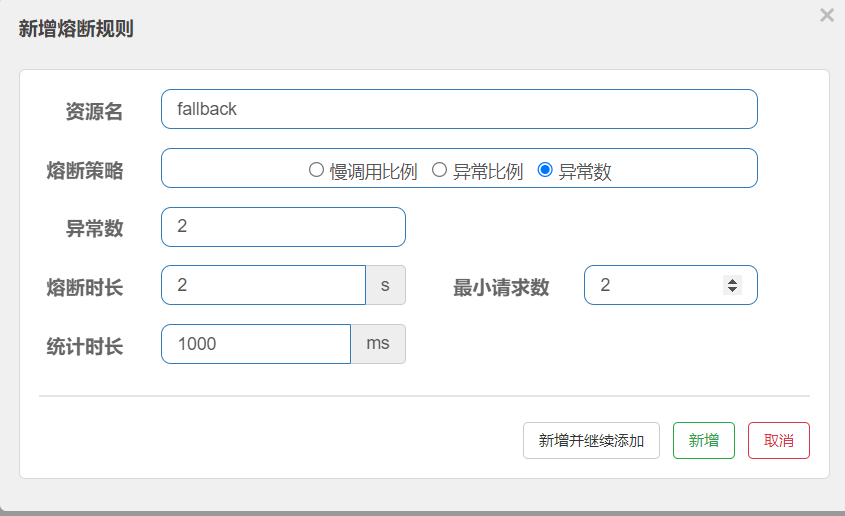
1秒内2次请求2个异常

# fallback+blockHandler都配置
@GetMapping(value = "/consumer/fallback/{id}")
// @SentinelResource(value = "fallback")//没有设置
// @SentinelResource(value = "fallback",fallback = "handlerFallback")//fallback只负责业务异常
// @SentinelResource(value = "fallback",blockHandler = "blockHandler")//blockHandler只负责sentinel控制台配置违规
@SentinelResource(value = "fallback",fallback = "handlerFallback",blockHandler = "blockHandler")
public CommonResult<Payment> fallback(@PathVariable("id") Long id){
CommonResult res = restTemplate.getForObject(SERVICE_URL + "/paymentSQL/" + id, CommonResult.class);
if (id == 4){
throw new IllegalArgumentException("IllegalArgumentException,非法参数异常.....");
}else if (res.getData() == null){
throw new NullPointerException("NullPointerException,该id没有对应记录,空指针异常.....");
}
return res;
}
public CommonResult<Payment> handlerFallback(@PathVariable("id") Long id,Throwable e){
Payment payment = new Payment(id, "null");
return new CommonResult<>(444, "兜底异常handlerFallback,exception内容 "+e.getMessage(),payment);
}
public CommonResult<Payment> blockHandler(@PathVariable("id") Long id, BlockException blockException){
Payment payment = new Payment(id, "null");
return new CommonResult<>(445, "blockHandler-sentinel限流,无此流水:blockException "+blockException.getMessage(),payment);
}
2
3
4
5
6
7
8
9
10
11
12
13
14
15
16
17
18
19
20
21
22
23
24
这里简单来说就区分,
- 如果sentinel的规则在业务之前执行(比如QPS),而出现不满足规则,此时不会走fallback
- 如果sentinel规则是慢调用、异常比例、异常数等,是在业务执行时后的,在还不满足规则时候,走fallback,满足规则后,走blockHandler
# 忽略属性
@SentinelResource(value = "fallback",fallback = "handlerFallback",blockHandler = "blockHandler",
exceptionsToIgnore = {IllegalArgumentException.class})
2
如果增加了这个配置,那么在方法中产生这个指定的异常时,就不会走fallback方法了
# 整合openfeign(84模块)
- 首先引入openfeign的依赖
# yaml
增加sentinel对feign的支持配置
feign:
sentinel:
enabled: true
2
3
# 主启动类
主启动类上增加
@EnableFeignClients注解
# 业务类
@FeignClient(value = "${service-url.nacos-user-service}",fallback = PaymentFallbackService.class)
public interface PaymentService {
@GetMapping(value = "/paymentSQL/{id}")
CommonResult<Payment> paymentSQL(@PathVariable("id") Long id);
}
@Component
public class PaymentFallbackService implements PaymentService{
@Override
public CommonResult<Payment> paymentSQL(Long id) {
return new CommonResult<>(44444, "服务降级返回,------PaymentFallbackService",new Payment(id, "errorSerial"));
}
}
//CircleBreakerController新增以下接口进行测试
// openfeign
@Resource
private PaymentService paymentService;
@GetMapping(value = "/consumer/paymentSQL/{id}")
public CommonResult<Payment> paymentSQL(@PathVariable("id") Long id){
return paymentService.paymentSQL(id);
}
2
3
4
5
6
7
8
9
10
11
12
13
14
15
16
17
18
19
20
21
22
23
24
# 测试
将payment9003/9004都关闭,进行测试,发现走了降级
# 对比
| Sentinel | Hystrix | resilience4j | |
|---|---|---|---|
| 隔离策略 | 信号量隔离(并发线程数限流) | 线程池隔离/信号量隔离 | 信号量隔离 |
| 熔断降级策略 | 基于慢请求、异常比率、异常数 | 基于异常比率 | 基于响应时间、异常比率 |
| 实时统计实现 | 滑动窗口(LeapArray) | 滑动窗口(基于RxJava) | Ring Bit Buffer |
| 动态规则配置 | 支持多种数据源 | 支持多种数据源 | 有限支持 |
| 扩展性 | 多个扩展点 | 插件的形式 | 接口的形式 |
| 基于注解的支持 | 支持 | 支持 | 支持 |
| 限流 | 基于QPS,支持基于调用关系的限流 | 有限的支持 | Rate Limiter |
| 流量整形 | 支持预热模式、匀速器模式、预热排队模式 | 不支持 | 简单的Rate Limiter模式 |
| 系统自适应保护 | 支持 | 不支持 | 不支持 |
| 控制台 | 提供开箱即用的控制台,可配置规则、查看秒级监控、机器发现等 | 简单的监控查看 | 不提供控制台,可对接其他监控系统 |
# 规则持久化
这里需要对规则进行持久化的原因是:在未持久化时,我们关闭受sentinel监控的应用之后,配置的相关规则就会消失
这里我们将限流配置规则持欠化进Nacos保存,只要刷新8401某个rest地址,sentinel控制台 的流控规则就能看到,只要Nacos里面的配置不删除,针对8401上sentinel上的流控规则持续有效
# 修改8401模块
# pom
新增依赖
<!-- 后续做持久化需要用到 -->
<dependency>
<groupId>com.alibaba.csp</groupId>
<artifactId>sentinel-datasource-nacos</artifactId>
</dependency>
2
3
4
5
# yaml
spring:
application:
name: cloudalibaba-sentinel-service
cloud:
nacos:
discovery:
#nacos 注册中心地址
server-addr: localhost:8848
sentinel:
transport:
# 配置Sentinel dashboard地址
dashboard: localhost:8080
# sentinel的端口 默认是8719 如果被占用会自动从8719开始依次+1扫描
# 直到找到未被占用的端口为止
port: 8719
# sentinel持久化配置
datasource:
ds1:
nacos:
server-addr: localhost:8848
data-id: ${spring.application.name}
group-id: DEFAULT_GROUP
data-type: json
rule-type: flow
2
3
4
5
6
7
8
9
10
11
12
13
14
15
16
17
18
19
20
21
22
23
24
# 新增配置
在nacos配置中心新增以下示例配置,与我们上面yaml中配置的data-id、group、data-type一致

# 测试
- 启动8401工程,访问http://localhost:8401/rateLimit/byUrl,再查看sentinel控制台,发现规则存在
- 又停止8401工程,再查看规则,发现规则消失
- 再启动8401工程,查看规则,规则没有,访问一两次接口后,规则出现

